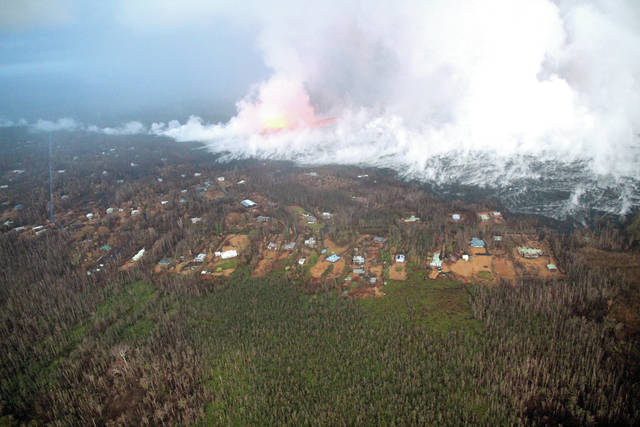Hawaii County officially confirmed Monday what had long been presumed true: At least 700 homes have been destroyed since May 3 when lava from Kilauea volcano began erupting in Leilani Estates.
While many estimated the number of homes destroyed was approximately 700 for the past month — among them Mayor Harry Kim, who guessed in June the number would be between 600 and 700 — official tallies have lagged behind as the county pored over tax records and aerial photos to determine the precise amount.
However, Janet Snyder, spokeswoman for Kim, confirmed the official tally has reached 700.
“That 700 number isn’t all of it,” Kim told the Tribune-Herald on Monday. “It doesn’t show what happened to everyone’s hopes and dreams.”
Kim himself lost a home in Kapoho, although he minimized his loss.
“My sadness about that isn’t about the home itself but what it represents,” Kim said, adding that he has been luckier than most others affected by the eruption.
“You sit down, you think about what 700 homes represents (and) all the people’s lives tied up in those places,” he said.
Kim said the tally does not include the consumed agricultural and floral lots, the destruction of which has left evacuees without jobs as well as homes.
Gus Becklund, who operated a fruit farm on Noni Farms Road near Highway 132 in lower Puna before the eruption, is one such evacuee. Since May 29, Becklund and his family have been staying in the Pahoa shelter.
“When it rains, it turns into a swamp, but people have been treating us really well,” Becklund said.
Although Becklund estimated his property was worth more than $500,000, he remains optimistic. He was approved for a Small Business Association loan and is hoping to buy a new home shortly.
“All things considered, our story is pretty good,” said Becklund. “I’m so grateful for all the agencies that have helped us.”
Snyder said Monday that one more home in Kapoho was consumed by the lava, leaving only three Kapoho Beach Lots homes standing.
Hawaiian Volcano Observatory scientist-in-charge Tina Neal said fissure 8 has shown little significant change within the past several days. Meanwhile, weak lava spattering continues at fissure 22 northeast of Leilani Estates.
“The wound is still bleeding,” Neal said about fissure 22.
National Weather Service meteorologist John Bravender said rising hot air from the lava flow has fed into a low pressure system over lower Puna, leading to heavy localized showers and thunderstorms. One rain gauge in Leilani Estates recorded 9 inches of rainfall within 24 hours Monday morning.
Bravender also said that, with the abundance of sulfur dioxide being emitted from the fissure, it is likely some of the rain in the vicinity and downwind of the eruption has become more acidic, although the extent of this and its consequences are still unclear.
The sulfur dioxide levels at Kilauea summit, meanwhile, have dropped to levels comparable to 2008, before the appearance of the lava lake in Halema‘uma‘u crater, Neal said.
The summit continues to be rocked by what Neal referred to as “collapse explosion events,” the semi-regular collapses of the caldera that are accompanied by tremors matching the energy output of a magnitude 5 earthquake. In the hours leading up to each collapse explosion event, Neal said 25-40 smaller quakes are felt each hour.
Near the summit, a sinkhole that opened Thursday evening on Highway 11 within the Hawaii Volcanoes National Park boundary has since been sealed, said spokeswoman Jessica Ferracane.
Back in the lower East Rift Zone, two California men were cited Sunday afternoon for being in the evacuation zone without authorization. Colin Malone, 31, and Kent Davis, 51, were cited on Pohoiki Road past Lava Tree State Monument.
While their citations are petty misdemeanors, under the governor’s disaster proclamation, they could be fined up to $5,000 and sentenced to one year in jail.
Email Michael Brestovansky at mbrestovansky@hawaiitribune-herald.com.









